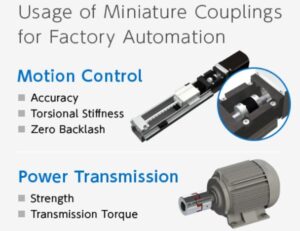How to select couplings
A simple and generally used method to select the most suitable coupling is the four step approach.
That is,
1. Select the coupling type suitable to the intended usage
2. Select the material of the coupling in line with the environment of usage
3. Select the coupling size fitted to the torque, space and bore size required
4. Select the fastening method between the shafts and the coupling
 Motion Control
Motion Control
Which type of miniature coupling should be used for “Motion Control” purpose?
Over a decade ago, “XH” Disk-type coupling, with all metal structure, was highly recommended because of its high torsional stiffness. However, because of improvements in motor performances, many engineers are selecting “XG” High-Gain Rubber type couplings.
By the combination of high vibration absorption capability and the optimum torsional stiffness, rubber type couplings avoid the co-vibration of the system, and realize the highest performance of the motor.
Yet there are still design engineers who want to continue to use the traditional types of couplings they are familiar with.
For these designers, there are “MBB” bellows couplings, which have high torsional stiffness next to the disk type.
And, we also have “MS” Slit couplings with simple monolithic structure. Of course, each type of coupling has a wide range of performances based on the different size or materials.
Therefore, please note that the chart you are looking at explains the comparisons of general characteristics of coupling types, as an “image chart”.
NBK
www.nbk1560.com
Leave a Reply